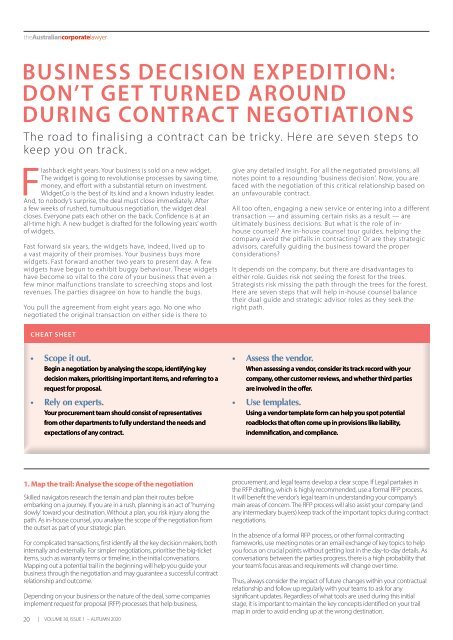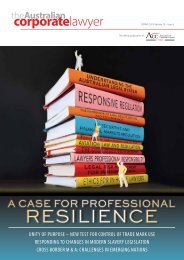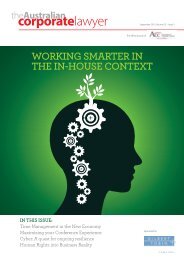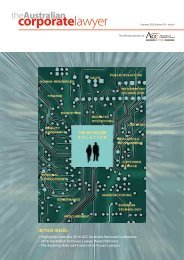Australian Corporate Lawyer - Autumn 2020
Australian Corporate Lawyer is the official publication of the Association of Corporate Counsel (ACC) Australia. The Autumn 2020 issue focuses on contract negotiation and features a range of articles covering topics including the importance of EQ for lawyers; managing employment rights in the social media age and addressing conflict in the workplace.
Australian Corporate Lawyer is the official publication of the Association of Corporate Counsel (ACC) Australia. The Autumn 2020 issue focuses on contract negotiation and features a range of articles covering topics including the importance of EQ for lawyers; managing employment rights in the social media age and addressing conflict in the workplace.
Create successful ePaper yourself
Turn your PDF publications into a flip-book with our unique Google optimized e-Paper software.
the<strong>Australian</strong>corporatelawyer<br />
BUSINESS DECISION EXPEDITION:<br />
DON’T GET TURNED AROUND<br />
DURING CONTRACT NEGOTIATIONS<br />
The road to finalising a contract can be tricky. Here are seven steps to<br />
keep you on track.<br />
Flashback eight years. Your business is sold on a new widget.<br />
The widget is going to revolutionise processes by saving time,<br />
money, and effort with a substantial return on investment.<br />
WidgetCo is the best of its kind and a known industry leader.<br />
And, to nobody’s surprise, the deal must close immediately. After<br />
a few weeks of rushed, tumultuous negotiation, the widget deal<br />
closes. Everyone pats each other on the back. Confidence is at an<br />
all-time high. A new budget is drafted for the following years’ worth<br />
of widgets.<br />
Fast forward six years, the widgets have, indeed, lived up to<br />
a vast majority of their promises. Your business buys more<br />
widgets. Fast forward another two years to present day. A few<br />
widgets have begun to exhibit buggy behaviour. These widgets<br />
have become so vital to the core of your business that even a<br />
few minor malfunctions translate to screeching stops and lost<br />
revenues. The parties disagree on how to handle the bugs.<br />
You pull the agreement from eight years ago. No one who<br />
negotiated the original transaction on either side is there to<br />
give any detailed insight. For all the negotiated provisions, all<br />
notes point to a resounding 'business decision'. Now, you are<br />
faced with the negotiation of this critical relationship based on<br />
an unfavourable contract.<br />
All too often, engaging a new service or entering into a different<br />
transaction — and assuming certain risks as a result — are<br />
ultimately business decisions. But what is the role of inhouse<br />
counsel? Are in-house counsel tour guides, helping the<br />
company avoid the pitfalls in contracting? Or are they strategic<br />
advisors, carefully guiding the business toward the proper<br />
considerations?<br />
It depends on the company, but there are disadvantages to<br />
either role. Guides risk not seeing the forest for the trees.<br />
Strategists risk missing the path through the trees for the forest.<br />
Here are seven steps that will help in-house counsel balance<br />
their dual guide and strategic advisor roles as they seek the<br />
right path.<br />
CHEAT SHEET<br />
••<br />
Scope it out.<br />
Begin a negotiation by analysing the scope, identifying key<br />
decision makers, prioritising important items, and referring to a<br />
request for proposal.<br />
••<br />
Rely on experts.<br />
Your procurement team should consist of representatives<br />
from other departments to fully understand the needs and<br />
expectations of any contract.<br />
••<br />
Assess the vendor.<br />
When assessing a vendor, consider its track record with your<br />
company, other customer reviews, and whether third parties<br />
are involved in the offer.<br />
••<br />
Use templates.<br />
Using a vendor template form can help you spot potential<br />
roadblocks that often come up in provisions like liability,<br />
indemnification, and compliance.<br />
1. Map the trail: Analyse the scope of the negotiation<br />
Skilled navigators research the terrain and plan their routes before<br />
embarking on a journey. If you are in a rush, planning is an act of 'hurrying<br />
slowly' toward your destination. Without a plan, you risk injury along the<br />
path. As in-house counsel, you analyse the scope of the negotiation from<br />
the outset as part of your strategic plan.<br />
For complicated transactions, first identify all the key decision makers, both<br />
internally and externally. For simpler negotiations, prioritise the big-ticket<br />
items, such as warranty terms or timeline, in the initial conversations.<br />
Mapping out a potential trail in the beginning will help you guide your<br />
business through the negotiation and may guarantee a successful contract<br />
relationship and outcome.<br />
Depending on your business or the nature of the deal, some companies<br />
implement request for proposal (RFP) processes that help business,<br />
20 | VOLUME 30, ISSUE 1 – AUTUMN <strong>2020</strong><br />
procurement, and legal teams develop a clear scope. If Legal partakes in<br />
the RFP drafting, which is highly recommended, use a formal RFP process.<br />
It will benefit the vendor’s legal team in understanding your company’s<br />
main areas of concern. The RFP process will also assist your company (and<br />
any intermediary buyers) keep track of the important topics during contract<br />
negotiations.<br />
In the absence of a formal RFP process, or other formal contracting<br />
frameworks, use meeting notes or an email exchange of key topics to help<br />
you focus on crucial points without getting lost in the day-to-day details. As<br />
conversations between the parties progress, there is a high probability that<br />
your team’s focus areas and requirements will change over time.<br />
Thus, always consider the impact of future changes within your contractual<br />
relationship and follow up regularly with your teams to ask for any<br />
significant updates. Regardless of what tools are used during this initial<br />
stage, it is important to maintain the key concepts identified on your trail<br />
map in order to avoid ending up at the wrong destination.
















